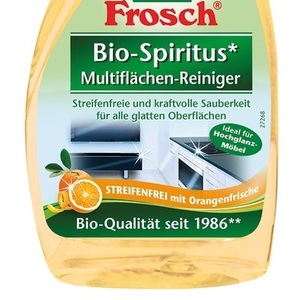Clariant: Cellulosic ethanol now used in cleaning agents

Clariant
February 18, 2016
BY Clariant
Clariant, a world leader in specialty chemicals, in cooperation with Werner & Mertz, the producer of Frosch products, has launched a project which expands the possible applications of bioethanol made from agricultural residues such as straw to detergents, cleansers and cleaning agents. sunliquid bioethanol has been used in Frosch Bio-Spirit Multisurface-Cleaner since the beginning of the year. As part of this, Clariant supplied the cellulosic ethanol, also called bio spirit, at the end of 2015 from its pre-commercial plant in Straubing, where up to 1,000 tons of cellulosic ethanol are produced annually using the sunliquid process.
“Bio-based chemicals from local straw, such as cellulosic ethanol, are truly sustainable and advanced active ingredients. The collaboration with Werner & Mertz demonstrates once again that products based on agricultural residues, which are produced without the use of fossil fuels and are not in competition with food supply, are also relevant in the consumer goods sector,” says Professor Andre Koltermann, Head of Group Biotechnology at Clariant. “We are very happy with the fact that we can realize this pioneering project with a renowned partner such as Werner & Mertz, and this demonstrates the diversity of the areas of application of our sunliquid® technology, which can also be implemented in other industries.”
Advertisement
Advertisement
Werner & Mertz, the family-run company based in Mainz, also welcomes the collaboration. With the “recyclate initiative” for packaging and the Frosch initiative for “locally-grown active ingredients,” the company has already been engaging in pioneering work in the field of sustainability for some time and wishes to further expand this through the use of another plant-based raw material, the sunliquid cellulosic alcohol. “At Werner & Mertz, we have a tradition of doing business based on the principle of sustainability. We always try to meet the needs of our customers with new and sustainable solutions. The collaboration with Clariant reaffirms our commitment to protect the environment and resources,” adds Reinhard Schneider, managing partner at Werner & Mertz.
Alcohol has been known for its grease and dirt-dissolving properties for decades. Through the use of cellulosic alcohol in Frosch Bio-Spirit Multisurface-Cleaner, these properties are coupled with sustainable and environmentally friendly manufacturing: due to its virtually carbon-neutral production, cellulosic ethanol saves up to 95 percent of CO2 emissions compared to synthetic ethanol from fossil resources. At the same time, it is produced from local residues and does not compete with food production or arable land.
Advertisement
Advertisement
Frosch Bio-Spirit Multisurface -Cleaner Orange has been produced with the sunliquid bio-alcohol since the beginning of this year and is available at German retailers as of February 2016.
Related Stories
CountryMark on July 22 celebrated the completion of more than $100 million in upgrades at its refinery in Indiana, including those related to soybean oil storage. The facility produces renewable diesel via coprocessing technology.
ATOBA Energy and Air Moana are partnering to implement scalable solutions for the supply of SAF. The collaboration aims to ensure long-term SAF availability while supporting local initiatives to develop sustainable fuel production in Tahiti.
Neste Corp. on July 24 released second quarter results, reporting record quarterly renewable product sales volumes despite weaker margins. SAF sales were up nearly 80% when compared to the first quarter of 2025.
Valero Energy Corp. on July 24 released second quarter results, reporting a profitable three-month period for its ethanol segment. The renewable diesel segment posted a loss, but the company’s new sustainable aviation fuel (SAF) unit operated well.
The IRS on July 21 published a notice announcing the 2025 calendar-year inflation adjustment factor for the Section 45Z clen fuel production credit. The resulting adjustment boosts maximum the value of the credit by approximately 6%.
Upcoming Events










